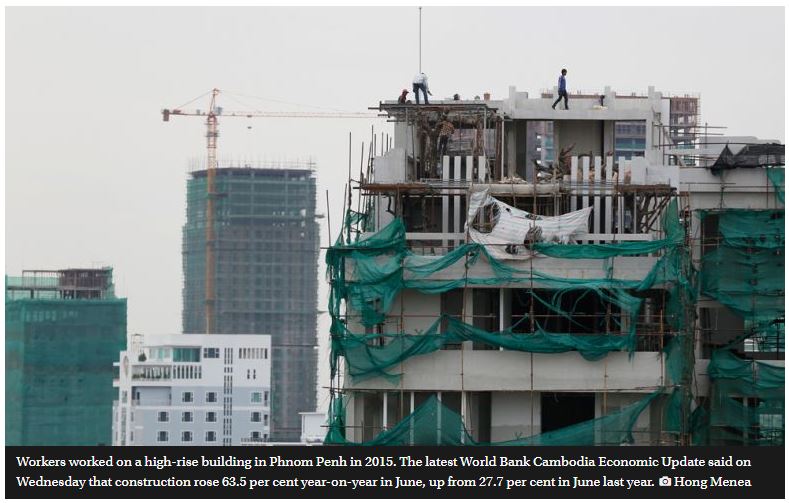Cambodia – World Bank: Growth at 7% for this year
Cambodia’s economy remained robust, underpinned by solid export performance and strong domestic demand, even as real growth is expected to decelerate to 7.0 per cent this year from 7.5 per cent last year, the latest World Bank Cambodia Economic Update said on Wednesday.
Garment and footwear exports, which account for around 70 per cent of total merchandise exports, grew 17.7 per cent last year but eased slightly to 15.3 per cent year-on-year in June this year, the report said.
Construction rose 63.5 per cent year-on-year in June, up from 27.7 per cent in June last year, it said.
The report noted that risks in the financial sector continued to grow, with increased exposure to the construction and real estate sectors alongside rising indebtedness – where combined bank and microfinance credit now accounts for more than 100 per cent of gross domestic product.
The EU’s potential withdrawal of its “Everything But Arms” (EBA) agreement, as well as a sharp slowdown in the Chinese economy, which is a possible outcome of continued Sino-US trade tensions, could substantially dampen the Kingdom’s growth prospects, it added.
World Bank country manager for Cambodia Inguna Dobraja said to enhance Cambodia’s external competitiveness, the authorities recently introduced measures to facilitate trade.
This, she said, included lowering logistics costs, cutting red tape and supporting businesses with a six-day reduction in the number of publicly observed holidays next year.
“A relatively large fiscal stimulus to be financed by the government could be introduced in 2020 to mitigate the negative impacts of the potential withdrawal of the EBA,” she said.
The report noted that Cambodia’s participation in the global economy, through global value chains (GVCs) grew faster than other comparative countries, albeit from a low base.
Dobraja said foreign direct investment inflows; a large pool of low-skill and low-wage labour; and preferential access to key export markets were behind Cambodia’s rapid integration into manufacturing GVCs.
“To move to the next stage of GVC participation, Cambodia will need a much more sophisticated policy mix.
“This would include expanding and deepening trade agreements, lowering barriers to imported inputs, and continuing to improve the education GVCs,” she said.
Chea Sopheak, the deputy director of the Ministry of Economy and Finance’s Macroeconomic and Fiscal Policy Department, said the Kingdom’s economic growth is in part due to reasonable labour costs in the garment sector compared to other developing countries.
The growth, he said was also partly attributable to the US’ Generalised System of Preferences (GSP) agreement.
“I believe we are successful in terms of GVC participation. First, labour costs are quite reasonable as they attract investors here, especially to the garment sector which is Cambodia’s largest.
“Second, GSP also attracts them [investors]. Then, there’s the business environment. There are more reasons [for that success], but for me, they are the three most important,” he said.
Phnom Penh SEZ Plc general manager Michelle Zhao said the private sector currently faces challenges brought about by the cut, make, trim (CMT) model for non-garment sectors.
Under the CMT method of production, the raw material, machinery and the garments’ designs are imported from abroad and product assembly is outsourced to labour-intensive factories in Cambodia.
Zhao said: “To upgrade GVC capabilities in Cambodia, the Royal Government should consider more significant policies for its non-garment factories.”
Currently, Zhao said, only Qualified Investment Projects in the garment sector are allowed more control over production. Non-garment manufacturers are not offered the same benefit.
Cambodia exported more than $7.97 billion worth of garment, textile and footwear (GTF) products in the first nine months of this year, up 13.18 per cent year-on-year from $7.044 billion, a report from the Ministry of Economy and Finance’s General Department of Customs and Excise said.
The US accounted for $2.5 billion of the exports and the EU $2.4 billion – with $670 million going to the UK, Japan $711 million, Asean member states $121 million and other countries $1.5 billion, the report said.
Source: https://www.phnompenhpost.com/business/world-bank-growth-7-year


 Thailand
Thailand




